An Essay for an Upgrade Economy
The rule synthesized is essentially this, you only upgrade when you WIN and SURVIVE a round. All expenses come from your winnings. What happens when you follow this rule? You will always have the money to buy a rifle and half-armor.
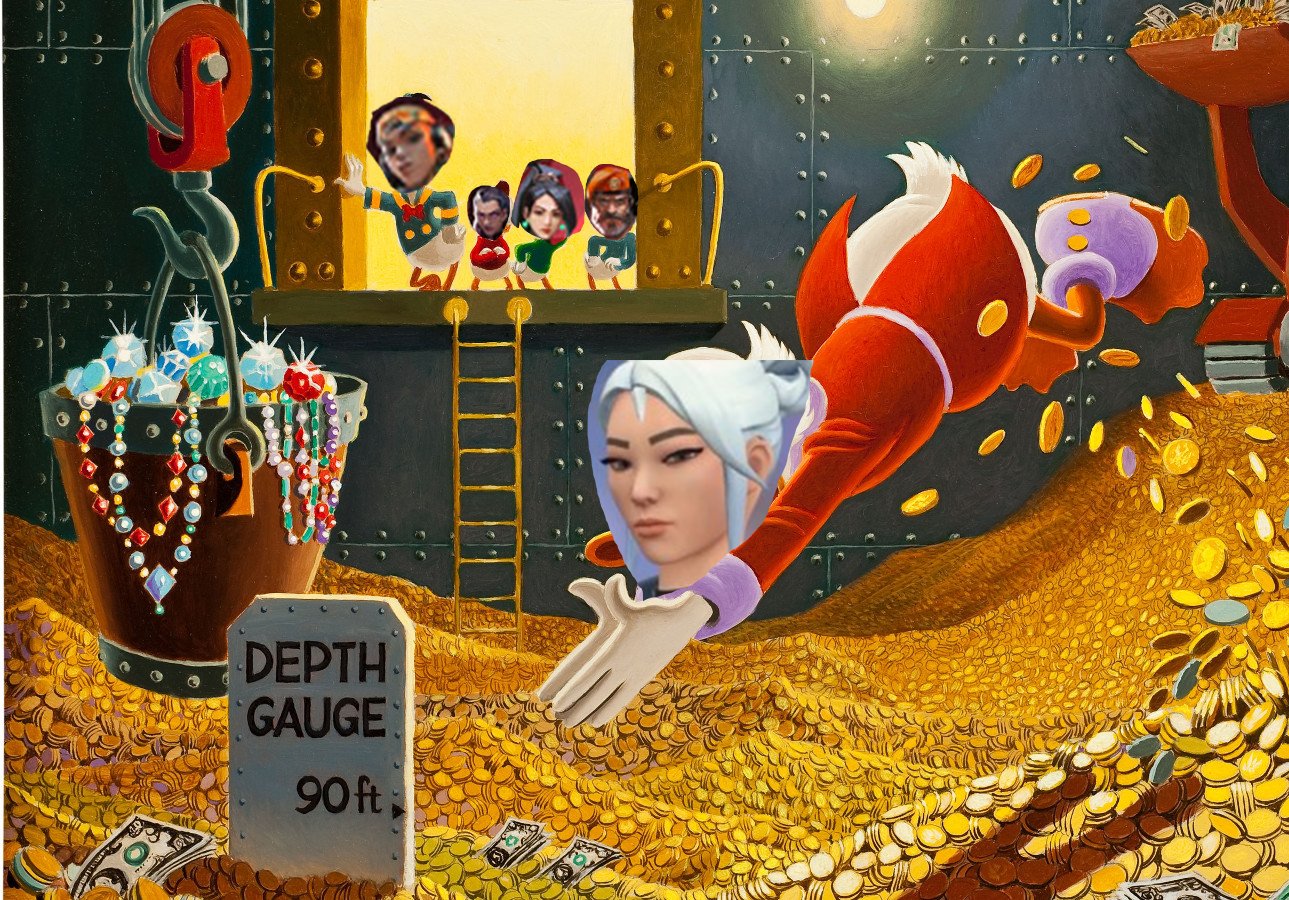
When you find yourself playing ranked, how often do you buy for a teammates? Do you ever wonder what leads someone to need to ask someone to buy for them? Why is it my turn now to buy you and then later off down the road it will be your turn to buy me? We follow this pattern and I don't think a lot of people understand what they're doing. Many players look at their economy as binary. Can I buy? Yes? No? And then we get in the weirdness of half buys. I too would like to sit down and listen to the dissertation of the player who buys a stinger 3 rounds in a row.
But who has time for that? I have to convince you that you might know nothing about the economy of Valorant. And that's fine. You're in really good company.
The rule synthesized is essentially this, you only upgrade when you WIN and SURVIVE a round. All expenses come from your winnings. What happens when you follow this rule? You will always have the money to buy a rifle and half-armor.
Explanation by showing you a 0/12 performance
In the cells below, what you will find is the outcome of a game where you lose every round and did not get an elimination or a spike plant but followed our buy strategy.
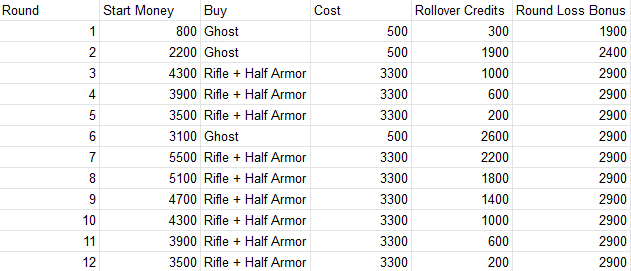
Now this is looking at worse case scenario and only if you bought a ghost for saves and rifle and half armor for all other rounds. What I want you to take a look at is the column labeled "Rollover Credits." This is basically what you take into the next round.
Notice how when we get below 400 credits, we are forced to save. This is because a rifle cost $2900 and the max loss bonus is $2900. Thus all you are ever deducting from your Rollover credits is the cost of the armor after loss bonus is maxed.
That 400 credits is the secret sauce.
There's a downside... but it's not what you think...
As you are aware, when you buy half-armor, you only get 25 armor. But that can be a bit misleading because incoming damage is affected by armor.
The calculations for armor is very straight forward, all incoming damage is reduced by 50%. This description was given by /u/Gay_Rudy on Reddit.
A 156 headshot damage of the Vandal will break your shield completely, in the meantime your hp is reduced by 156/2=78 (hp=100-78=22).
Now there is some left over damage that the shield cannot absorb anymore => 78-50=28. Substract the 28 damage from your 22 remaining hp => one-shot headshot.
If we synthesize those statements, here is more or less the rule:
- Apply damage number (156)
- Divide damage number by 2 if there is armor.
- The result of the damage number divided by 2 is applied to the hp.
- Any left over damage that is not covered by the armor, is applied straight to the hp (kinda like true damage).
Well if this is the first time you've seen the armor or shields calculation, congrats! Because it doesn't mean anything at all really.
PHANTOM'S DAMAGE NUMBERS
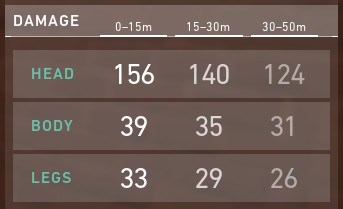
VANDAL'S DAMAGE NUMBERS
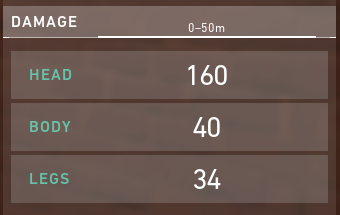
A Phantom head shot at 14m or less is 156 damage. It's a one shot elimination. A Vandal head shot at all distances is 160 damage. It's a one shot elimination.
These are boring. The body shots is where us baddies' magic happens. Below are the health and armor numbers when a shot is registered as a body shot:
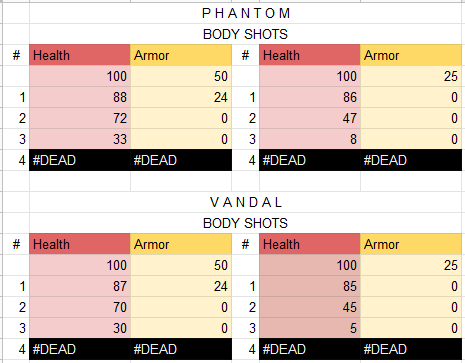
Looking at these numbers you might miss it. You really should just look at the graph for a second and I shouldn't have to tell you. I'll give you a hint, look at the number of rows. THEY'RE ALL THE SAME. You're probably like "NANI!?!?!?!?"
That's right, if you're playing against rifles, whether it is the Phantom or the Vandal, it takes four body shots to eliminate a player, regardless if the player has half armor or full armor.
And sorry but if you're shooting legs, this article isn't probably going to help much :)
(But if you're thinking this way you're on to something...)
APPLICATION OF THE RULE
Honestly, we can get even more specific, it comes down to the fall off damage of the Phantom. The Vandal isn't apart of the equation because of the flat damage. If you are shot in the head with a Vandal at any distance, it's a one-shot elimination.
So why does fall off damage matter? Well the best counter to my argument is that there is a space where the values of 125-150 damage matter.
BUT if we are able to contain our fights and not let them get outside of the range of 0-15m, we can mitigate the negatives. In layman's terms, if we keep the fight in a small space then we can throw out the values that extend beyond 15m and work with the damage values of just the 0-15 range. This simplifies our efforts.
600 Credit Pistol and SMG Insurance
When you buy full armor, you're essentially saying, "I believe that I am going to take damage specifically within the 125-150 damage range." That specifically can be the only logically reason as we proved that against a rifle, you can't hit these damage ranges as each rifle takes four body shots to kill.
So how do we get to the 125-150 damage range? Well there are a couple different ways but the majority will be from lesser guns, leg shots, pistols and agent abilities. A more uncommon way may also be being shot through objects such as walls or boxes. But is it worth it?
Valorant has a variety of different guns. Each one suited for specific situations. For example, a Bucky (the pump shotgun) can one shot someone with full armor at close range. Armed with this information, you should use Bucky's at close range. An Operator can do the same but for long distances. A SMG allows you to prioritize movement over aiming. Each weapon puts a different spin on the situation.
But you usually don't know what your opponent has as a weapon until you meet them face to face. So in the end, does it even matter? We are playing a game of information gathering through one means or another.
The boring part is that I can't tell you if it matters. You have the make that decision based on your play style. Are you disciplined enough to hold corners and only go for head shots? Or are you the type of player that is more fluid and like a bit of movement in their lives. You decide.
WE'VE ARRIVED TO THE UPSIDE
I've shown you what happens when you go 0/12. But what happens when you win?
When you win you get 3000 credits. If you bank that money it could get you 7 rounds of half armor (2800/400 = 7), right? Unfortunately no. Even after our first win we have to take something else into account. Loss Bonuses. If we win, our loss bonuses are reset. If we lose the next round, we only get 1900 credits. This is 1400 short of our goal of 3300 credits to buy rifle and half armor. Here are how the numbers play out:
First Loss Bonus = 1900. In order to get to 3300 we need 1400 credits.
Second Loss Bonus = 2400. In order to get to 3300 we need 1000 credits.
Third Loss Bonus = 2900. In order to get to 3300 we need 400 credits.
When you add up the amounts that you need, you get 2800 credits. That's just 200 short of the win bonus at 3000.
So really in order to get me back to a state where I can reset my money and we can ignore the loss bonus, I need to bank 2800 credits to offset the loss round bonuses I don't receive when I don't lose consecutively in a half.
Which means the first time I win, I should only spend 200 credits as I need to anticipate resets of future loss bonuses. This is only necessary though when you lose 3 consecutive rounds. At any point, if you win, you add the additional 3000 credits and instantly improve your situation.
DON'T SPEND IT RIGHT WHEN YOU GET IT!
Essentially you can instantly derail your economy by not saving for the loss bonus reset. And this typically happens in a binary-buy world. You win a round and you get eliminated, most players will full buy with full armor. They feel the pressure to match their teammates equipment. Essentially spending more than the 3000 credits they earned from the win. And that's where the situation gets dire and can mess up buys and throw your whole team's economy into a mess.
When really what you should do is buy a rifle and half armor. Matching fire power but not health pool. We can offset the health pool by effectively intertwining abilities and teammates.
If we survive, we don't instantly buy. We look at our economy and see if we can absorb the loss bonus deficit if we go on a string of losses. If we can, we can then upgrade abilities and even to full armor. Any money spent is money earned through winning. All other money is banked to support our consistent buy strategy.
ALL ROUNDS ARE NOW WINNABLE
One of the key elements of a "save" is a difference in money spent on firepower. In tactical FPS games, a team that is saving is usually much weaker than their opponents. But then there was the introduction of the half-buy. Teams would use weapons and place themselves in situations where the weapon gave them an advantage.
The upgrade economy just seems to be the next evolutionary step. If you go 0/12 in a game using this strategy, you had 9 rounds where you had a rifle and half armor. Like the half-buy you put yourself in advantageous situations which simplify your approach to angles and your opponent. Hopefully with a little bit of luck, you'll never save again.